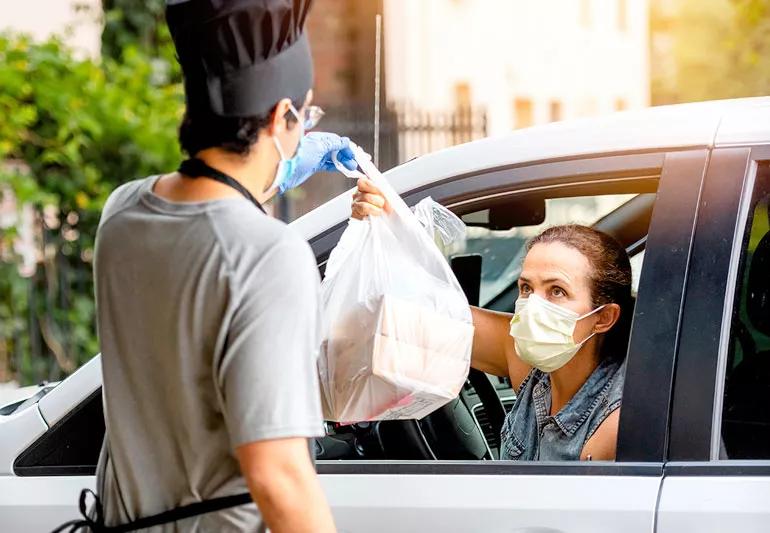Delivery, patio eating and dining in have different levels of risk

As the coronavirus pandemic drags on, many of us yearn for the days of sitting in a restaurant. There’s something wonderful about eating food you didn’t cook off dishes you don’t have to wash.
Advertisement
Cleveland Clinic is a non-profit academic medical center. Advertising on our site helps support our mission. We do not endorse non-Cleveland Clinic products or services. Policy
Maybe your favorite restaurant is now open for business, and you’ve thought about going, but still feel unsure about whether it’s safe to eat out during the pandemic. And while many establishments have created seating plans that incorporate social distancing, you still might be wondering if these new arrangements or even patio seating makes dining out safer right now.
Donald Dumford, MD, internal medicine specialist, shares some things to consider before you eat out.
If you’re missing that amazing house sirloin from the steakhouse across town, go ahead and order it. But to keep your coronavirus risk to a minimum, opt for takeout or delivery.
Many restaurants offer curbside pickup, carryout or delivery options — even if they didn’t have these choices before.
“Carryout or delivery is the safest way to eat out right now,” Dr. Dumford says. “Your interaction with other people is short and limited. Wash your hands before and after getting your food, and wear a mask during pickup or delivery.”
If the weather is agreeable, you may be thinking about dining on a patio at your local restaurant. But it’s not a foolproof way to avoid the virus.
“If the tables are spaced at least six feet apart, eating outdoors is safer than eating inside,” Dr. Dumford says. “But there’s still some risk of getting the virus because you’re around other people.”
Consider your acceptable level of risk. “People who have low risk factors for the coronavirus may be comfortable eating on a restaurant patio,” he says. “Older adults or those who have health conditions may not want the risk.”
Advertisement
If you choose patio dining, make sure the restaurant has strict policies on mask-wearing and social distancing. Even outdoors, tables should be at least six feet apart. Customers should wear masks when they’re not seated, and employees should wear them all the time.
Eating inside a restaurant — big shocker — carries the highest risk. In a recent study, adults who tested positive for the coronavirus were about twice as likely as those who tested negative to have been to a restaurant.
If you decide to eat in, check the restaurant’s safety measures. Look on the website or call and ask if the staff is:
Even if the answer to all of these questions is “yes,” there’s still a risk that you could get exposed to the virus.
“Social distancing and disinfecting don’t eliminate all risk,” Dr. Dumford says. “If someone coughs or laughs, they can exhale a cloud of virus. People are not wearing masks while eating, so there’s a higher risk at a restaurant versus a place where everyone is masked at all times.”
Dr. Dumford recommends avoiding restaurants that use shared areas and objects – think salad bars, drink machines and other self-serve options. Even restaurant menus can be germy.
“Anytime you’re touching an item that someone else has touched, like a pair of salad tongs, you risk getting germs on your hands — including the coronavirus,” he says. “Avoid these items whenever possible. If you can’t, sanitize your hands before and after touching shared items. And don’t touch your face.”
A major factor to consider is the restaurant’s heating, ventilation and air conditioning (HVAC) system. The World Health Organization says a well-maintained, clean HVAC system can reduce the risk of spreading the coronavirus if there’s plenty of outdoor airflow.
And a poorly maintained system could allow those viral particles to float around and spread to others. But there’s no way to know whether a restaurant’s HVAC system is doing its job. Instead, look for lots of open windows. The fresh air coming in may lower the risk because it gets rid of some recirculated air.
But be wary of fans. “Restaurants should avoid using fans that blow air between tables,” Dr. Dumford says. “If you’re downwind from someone who has the virus, the fan could blow the virus right at you.”
In most restaurants, servers must wear masks at all times, but customers can remove them once they’re seated.
“Ordering food without a mask on puts your server at risk,” Dr. Dumford says. “If you see your server approaching your table, put your mask back on. It’s a great way to say you care about protecting them.”
Advertisement
Some people are concerned that they could get the coronavirus from their food. But experts say this isn’t the case. The Centers for Disease Control and Prevention says there is “no evidence” of transmitting COVID-19 through food.
“Always wash your hands before eating or preparing food,” says Dr. Dumford. “But don’t be overly concerned about the coronavirus living on your meal and spreading to you. It’s not likely to happen.”
You have options when it comes to eating out. But if you decide to dine in, there’s a higher risk of exposure to the coronavirus. This may not worry you personally, but think about high-risk people you spend time with. If you’re seeing Grandma next week or your dad has health issues, delivery or carryout may be your friend. Enjoying your favorite foods from the comfort of your couch or backyard certainly has its own unique appeal.
Advertisement
Learn more about our editorial process.
Advertisement

Most can return to work or school when they’re symptom-free for 24 hours

Covering your mouth when you cough and staying home when you’re sick are a couple ways to help keep yourself and others COVID-free

This vital nutrient supports your health, but its role in COVID-19 prevention and treatment isn’t proven

Studies have shown promising results, but additional research is needed

Infection and inflammation can cause you to lose your voice and have other voice changes until you’re fully healed

A COVID-19 infection can bring on depression or anxiety months after physical symptoms go away

Just like the flu, COVID-19 continues to evolve every year with new and smarter variants

The latest omicron subvariants carry specific mutations that may allow the SARS-CoV-2 virus to be better at evading immune protection

Start having sex about 72 hours before ovulation, then at least every other day during your fertile window

Attachment theory suggests that your earliest relationships shape connections throughout your life

It isn’t a recognized mental health disorder, but research shows that problematic social media use can negatively affect your mental health, self-esteem and sleep